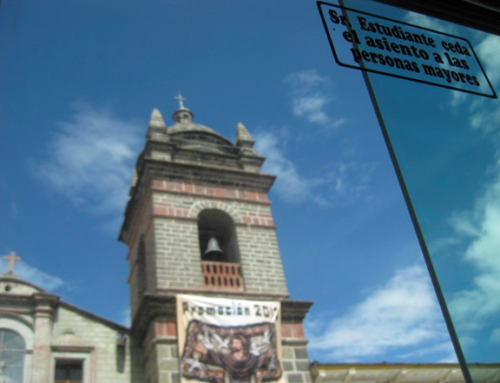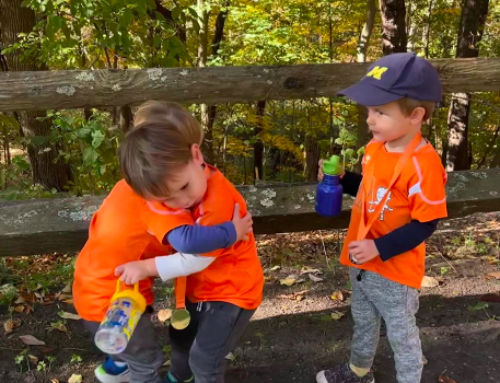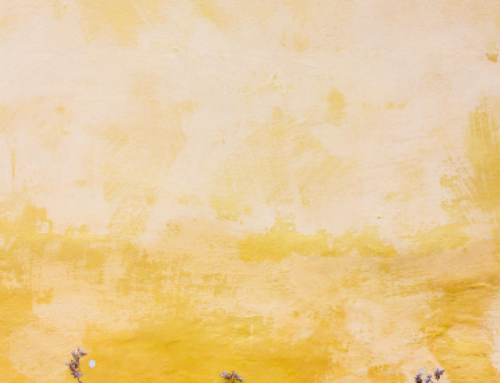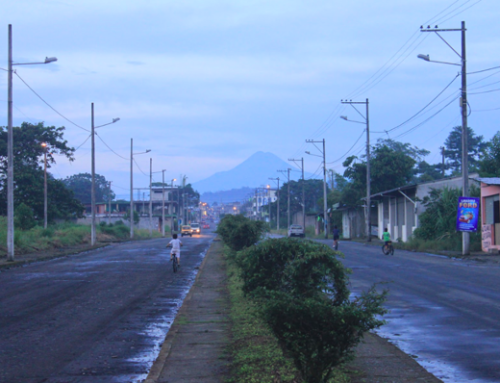It’s a familiar sensation. It seizes my hands with a prickling, convulsive pain. Some say when you’re nervous before a public engagement or presentation, your hands shake. Mine don’t. Instead, my fascia tightens up and contracts. My finger joints expand, as if to grow beyond the skin and muscles that encase and hold them. So much for being an observer, a spectator. How did I end up on this stage allowing more than 20 people to look at me?
I stood on the makeshift stage with two chairs on each side. I intentionally put one of the chairs on the periphery, with the other positioned closer to me. I turned my back to the audience. The chairs and I faced away from each other too, as if refusing to engage in any way. This was one of the exercises that took place at the inclusive theatre workshop organized by Deistvie Bukval’no (Action Literally) theatre group in Astana. Deistvie Bukval’no is the first inclusive theatre group in Kazakhstan, created especially for professional actors and actors with cognitive disabilities. I had flown to Astana from Almaty in early December to conduct ethnographic research and participant observation at the workshop. Katya Dzvonik and Alexey Krasniy, the group’s theatre educators, told me I must partake, otherwise I would not understand the experience. (Did I mention I have a very hard time saying no to people?) The instructions for the exercise were simple: go on the stage and use the chairs to tell a story. The chairs for the exercise were given roles—they were to play the parts of a mother and a father. We could move the chairs and our own bodies on the stage, however we wanted. I wanted them facing away from me.

Khalev Musayev, an actor of the Deistvie Bukval’no (Action Literally) theatre group during the parent-chairs exercise in Astana. Photo credit: Veronika Lerner.
The snapshot story of absent or painfully present relationships that I offered there might not necessarily be what audience members saw for themselves. Yet, I don’t think the exercise was meant to be a charade game where the audience had to guess what I was trying to convey. In his public lecture on “Theatre in the Empire,” Kesha Bashinskiy, a researcher and co-organizer of an inclusive theatre studio AdamdArt(PeopleArt), insists on theatre as necessarily a form of co-presence—a co-participation that refuses being embalmed into artefacts (2023). In other words, theatrical engagement, unlike, say, painting or film, requires living through and co-experiencing an event together, in a moment. This refusal to be reduced to an artefact speaks to what Grøn and Mattingly define as an imagistic approach to care, which is a “quality of experience, a relational quality, rather than a feature of an object” (2022, 20; italics mine). Co-presence and co-participation unsettle the idea of an “image-as-a representation” (2022, 20). Hence, an engagement with, say, my presence on the stage and the placement of the chair-parents may be less about the interpretation of an “image-as-a representation” of parent-child relationship. Instead, as facilitated by the practices of an inclusive theatre, such an engagement might allow an actor and spectators this experience of co-living through a moment of vulnerability. Bashinskiy reminds us that an inclusive theatre space is a safe co-presence, where space and people enfold you in your difference and particularity.
The second exercise that took place during the workshop was called “A Photographer and a Camera.” For this exercise, we were asked to organize ourselves into pairs. Bota, an actor of the Deistivie Bukval’no theatre who came to Astana from Almaty to help conduct the workshop, walked across the room to me and said, “I like you; we will pair up.” I smiled self-consciously and nodded. She exuded an infectious kind of confidence and self-assurance. In the exercise, one person is to become a camera, and the other is to become a photographer. The camera closes her eyes, and the photographer leads the camera by holding her hand. The photographer presses on the camera’s hand and says “Chikchik!” In that moment, the camera opens her eyes-lens and takes a mental picture of whatever is in front of her. I offered to be the camera. As people got into pairs and started the exercise, we did too. I closed my eyes and let her lead me around the room. With so many people moving around in the room, I was worried about bumping into people, but Bota led me firmly and gently. At some point, Bota stopped me. She pressed on my upper back, making me lean forward. Then she pressed on my hand and said, “Chikchik!” I opened my eyes for a moment, taking in the wall in front of me, the midday sunlight playing on the blue letters. (There was a quote from the current president, something about the future of the nation and the importance of family.) I closed my eyes, and then she turned me around and led me to a different part of the room.
Mattingly (2022, 34) writes about imagistic approaches to care, where we as researchers in the field do not (only) attend to fixed social facts, structures, and histories, but instead, pay attention to “stubborn particularities that emerge in our fieldwork.” Such particularities “help us not merely see something as something, but to see something through something” (34). What particularities emerged in this exercise? What exactly did I see through my camera/eyes? In some ways, this did not seem so different from other research methods we have in our anthropological toolkit. Yet, unlike an interview or an oral history, I did not ask questions. Instead, Bota took me on an imagistic journey. It was a journey where we moved our bodies through the space of a large conference room, familiarizing ourselves with shapes, colors, smells, textures, and other bodies present with us. Even beyond this, it was an imagistic narrative of care that led her on this journey, to be an actor helping facilitate a workshop. It was clear that Bota had done this exercise before; it was not her first time instructing and helping non-actors in a workshop setting. She had sensed my nervousness, and had made it clear that I would be fine.
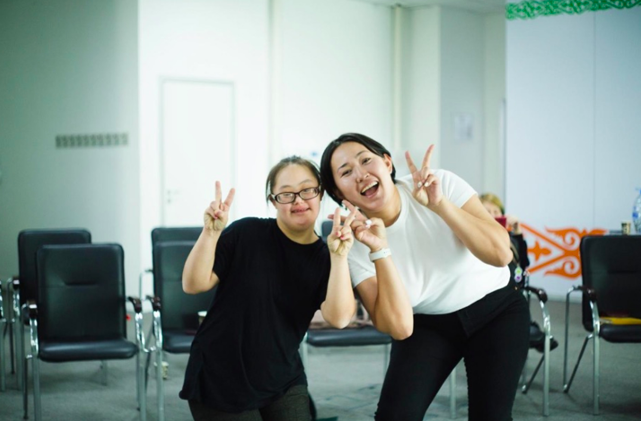
Actor Bota Zhanadil (left) posing with Gyuzel Kamalova (right) after the first day of the workshop in Astana. Photo credit: Veronika Lerner.
As an actor with Down’s Syndrome, Bota commanded the attention of the mothers of children with cognitive disabilities who brought their adult children to participate in the workshop. The mothers expressed concerns about their adult children, like many parents who worry about what will become of their children in the future, when they are no longer around. Bota, alongside other actors with disabilities, offered a glimpse into a different future, a different potentiality. “How come she flew from Almaty! On her own!”, exclaimed one of the mothers at one point. She arrived with the theatre group; they did not coddle her but instead provided her with the care and support necessary to make her work possible. Katya Dzvonik insisted that in the beginning of their work it was critical to cultivate an “I want” position in actors with disabilities. This was especially important, she said, for those who previously had never really been asked what they wanted by their families and extended networks of care. More importantly, the care work involved in fostering a collective where actors with disabilities felt that their wants and needs mattered and was foundational to the artistic engagement. Through her work, Bota refused to be reduced to a token actor with a disability, just as she refused to be a success story. She refused such transparent simplicity, and instead offered what Mattingly, citing Edouard Glissant (1997) calls “vitalizing opacity” (2020, 34). There was and is a much deeper complexity to her experience of becoming an actor and an educator within the larger context of a deeply ableist Kazakhstan.
On the final day, Olga Sultanova, the producer of the theatre group, asked Bota if she could share a story about her. Bota nodded in agreement. “One day,” Olga started, “Bota’s parents could not drive her to rehearsal, so she had to skip.” But Bota did not want to skip rehearsal; in fact, she insisted on going, even if she had to go on her own. After much yelling and arguing, her parents called the theatre group. They, in turn, promised to pick her up from the taxi and then return her home in a taxi. That was Bota’s first—but of course, not last—outing on her own. This anecdote shared by Olga, with Bota’s permission, signals an expansion of the care network from immediate family to her professional artistic family—an expansion that was prompted and demanded by Bota herself. In fact, she is part of her own care network in that she is not only a recipient of care, but she also actively participates in care-informed educational work and creates artistic work within and through these networks of relations.
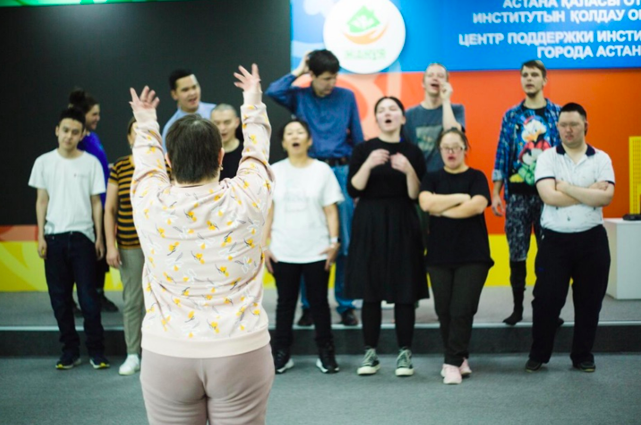
Discordant choir exercise. Workshop participants perfectly out of tune and yet in tune with each other. Photo credit: Veronika Lerner.
Tronto and Fisher capaciously defined care as an “activity that includes everything that we do to maintain, continue, and repair our ‘world’ so that we can live in it as well as possible.” (1993, 103). Such an approach to care resonates deeply in these unsettling times for many Kazakhstanis, where among other painful events and ongoing violence in the region, the truths and trauma of the Qandy Qantar1 (Bloody January) are not fully understood. For local disability communities, everyday life and possible futures are unsettled by an undeniable ableism and uncertainty. Yet, world-sustaining and world-building practices are beautifully reflected in the artistic work of inclusive theatres in Almaty. What new artistic engagements—what new worlds—will Bota, and her colleagues create? How many more life-worlds will they touch? I sure know that I’m raptly following along. For after they folded me, an anxious stray anthropologist, into their care-infused co-presence and co-participation, I wouldn’t know how to feel and be otherwise.
Notes
[1] Mentioning Qandy Qantar (Bloody January) is imperative. It is impossible to think about current experiences of Kazakhstanis outside the violence and trauma of Qandy Qantar. Accounts written in Western media were insultingly partial. That is why I suggest being on a lookout for Qantar Jazylu, a project involved in healing through writing by those who were here in Kazakhstan in January 2022.
Acknowledgements
A big thanks to Bota, Katya, Olga S., Olga M., Alexey K., and everyone else at Deistvie Bukval’no for allowing me to join the workshop. Thanks to my supervisor Janelle S. Taylor for nudging me to start writing, and my dear friend and colleague Do-Hyeong Myeong for all the insightful questions and a careful reading of an early draft. This research is supported by the SSHRC Doctoral Fellowship and Wenner-Gren Doctoral Dissertation Fieldwork Grant.
References
Glissant, Édouard. 1997. Poetics of Relation. Ann Arbor: University of Michigan Press.
Grøn, Lone and Cheryl Mattingly. 2022. Imagistic Care: Growing Old in a Precarious World. Edited by Lone Grøn and Cheryl Mattingly. First edition. New York: Fordham University Press.
Tronto, Joan C. 2020. Moral Boundaries: A Political Argument for an Ethic of Care. London: Routledge.
Gyuzel Kamalova is a PhD Candidate in anthropology at the University of Toronto. Her doctoral research focuses on the social life of cognitive disability diagnosis in Kazakhstan.
